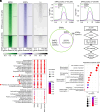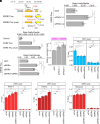ERRα and ERRγ coordinate expression of genes associated with Alzheimer's disease, inhibiting DKK1 to suppress tau phosphorylation
- PMID: 39231208
- PMCID: PMC11406303
- DOI: 10.1073/pnas.2406854121
ERRα and ERRγ coordinate expression of genes associated with Alzheimer's disease, inhibiting DKK1 to suppress tau phosphorylation
Abstract
Alzheimer's disease (AD) is a prevalent neurodegenerative disease characterized by cognitive decline and learning/memory impairment associated with neuronal cell loss. Estrogen-related receptor α (ERRα) and ERRγ, which are highly expressed in the brain, have emerged as potential AD regulators, with unelucidated underlying mechanisms. Here, we identified genome-wide binding sites for ERRα and ERRγ in human neuronal cells. They commonly target a subset of genes associated with neurodegenerative diseases, including AD. Notably, Dickkopf-1 (DKK1), a Wnt signaling pathway antagonist, was transcriptionally repressed by both ERRα and ERRγ in human neuronal cells and brain. ERRα and ERRγ repress RNA polymerase II (RNAP II) accessibility at the DKK1 promoter by modulating a specific active histone modification, histone H3 lysine acetylation (H3K9ac), with the potential contribution of their corepressor. This transcriptional repression maintains Wnt signaling activity, preventing tau phosphorylation and promoting a healthy neuronal state in the context of AD.
Keywords: Alzheimer’s disease; DKK1; PROX1; Wnt signaling pathway; estrogen-related receptor.
Conflict of interest statement
Competing interests statement:The authors declare no competing interest.
Figures






Similar articles
-
Interplay between estrogen-related receptor alpha (ERRalpha) and gamma (ERRgamma) on the regulation of ERRalpha gene expression.Mol Cell Endocrinol. 2007 Jan 29;264(1-2):128-41. doi: 10.1016/j.mce.2006.11.002. Epub 2006 Dec 8. Mol Cell Endocrinol. 2007. PMID: 17157980 Free PMC article.
-
Clusterin regulates β-amyloid toxicity via Dickkopf-1-driven induction of the wnt-PCP-JNK pathway.Mol Psychiatry. 2014 Jan;19(1):88-98. doi: 10.1038/mp.2012.163. Epub 2012 Nov 20. Mol Psychiatry. 2014. PMID: 23164821 Free PMC article.
-
Inhibition of Wnt signaling, modulation of Tau phosphorylation and induction of neuronal cell death by DKK1.Neurobiol Dis. 2006 Nov;24(2):254-65. doi: 10.1016/j.nbd.2006.06.016. Epub 2006 Aug 17. Neurobiol Dis. 2006. PMID: 16919965
-
The role of DKK1 in Alzheimer's disease: A potential intervention point of brain damage prevention?Pharmacol Res. 2019 Jun;144:331-335. doi: 10.1016/j.phrs.2019.04.033. Epub 2019 Apr 28. Pharmacol Res. 2019. PMID: 31042564 Review.
-
Estrogen regulation of Dkk1 and Wnt/β-Catenin signaling in neurodegenerative disease.Brain Res. 2013 Jun 13;1514:63-74. doi: 10.1016/j.brainres.2012.12.015. Epub 2012 Dec 19. Brain Res. 2013. PMID: 23261660 Free PMC article. Review.
Cited by
-
Research progress on resistance exercise therapy for improving cognitive function in patients with AD and muscle atrophy.Front Aging Neurosci. 2025 Apr 8;17:1552905. doi: 10.3389/fnagi.2025.1552905. eCollection 2025. Front Aging Neurosci. 2025. PMID: 40271180 Free PMC article. Review.
References
-
- Hardy J., Selkoe D. J., The amyloid hypothesis of Alzheimer’s disease: Progress and problems on the road to therapeutics. Science 297, 353–356 (2002). - PubMed
MeSH terms
Substances
Grants and funding
LinkOut - more resources
Full Text Sources
Medical
Molecular Biology Databases

